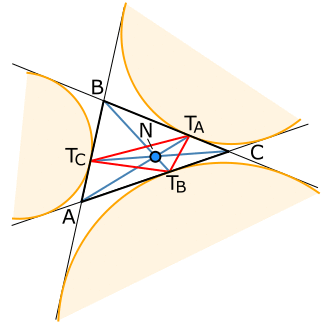
In geometry, the extouch triangle of a triangle is formed by joining the points at which the three excircles touch the triangle.
The vertices of the extouch triangle are given in trilinear coordinates by:
or equivalently, where a,b,c are the lengths of the sides opposite angles A, B, C respectively,
Related figures
The triangle's splitters are lines connecting the vertices of the original triangle to the corresponding vertices of the extouch triangle; they bisect the triangle's perimeter and meet at the Nagel point. This is shown in blue and labelled "N" in the diagram.
The Mandart inellipse is tangent to the sides of the reference triangle at the three vertices of the extouch triangle.[1]
Area
The area of the extouch triangle, , is given by:
where , , are the area, radius of the incircle and semiperimeter of the original triangle, and , , are the side lengths of the original triangle.
This is the same area as that of the intouch triangle.[2]
References
- ^ Juhász, Imre (2012), "Control point based representation of inellipses of triangles" (PDF), Annales Mathematicae et Informaticae, 40: 37–46, MR 3005114.
- ^ Weisstein, Eric W. "Extouch Triangle." From MathWorld--A Wolfram Web Resource. http://mathworld.wolfram.com/ExtouchTriangle.html